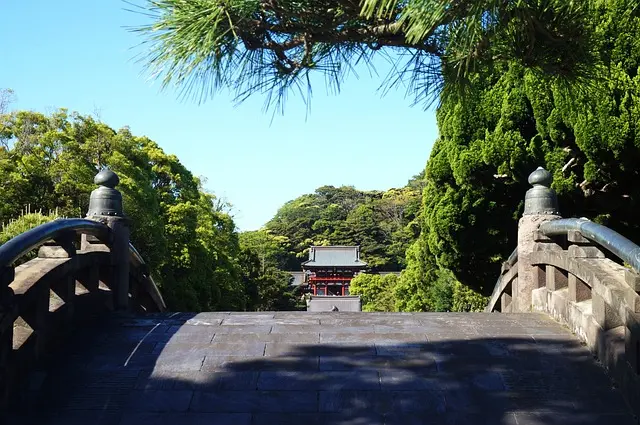
Stop 1: Engaku-ji
Highlights: The oldest Chinese-style architecture in Japan
Located right next to Kita-Kamakura Station, Engaku-ji, founded in 1282, is a classic example of Chinese Buddhist temple design and is Japan’s oldest existing Chinese-style building. It’s especially popular in autumn, when ginkgo, maple, and pine trees paint the temple grounds in vibrant hues of gold and crimson.
A must-try experience here is sipping matcha tea at the temple’s secluded sub-temple, Butsunan (an additional fee applies). While matcha desserts are common across Japan, enjoying a cup of authentic matcha in this tranquil and historic setting offers a unique and memorable experience.
• Admission: Adults ¥300, Children ¥100
• Hours: 8:00–17:00
Stop 2: Meigetsu-in
Highlights: The renowned “Meigetsu-in Blue” hydrangeas
Known as the “Hydrangea Temple,” Meigetsu-in becomes a spectacle during hydrangea season (June-July), when its famous “Meigetsu-in Blue” hydrangeas blanket the temple grounds. The steps leading to the temple, surrounded by blooming flowers, have become an iconic image of Kamakura tourism.
Even outside hydrangea season, Meigetsu-in is adorned with seasonal blooms, a dense bamboo grove, and traditional Japanese gardens. The harmonious interplay of flowers and ancient structures creates stunning scenery year-round.
• Admission: ¥300
• Hours: 9:00–16:00
Stop 3: Kencho-ji
Highlights: A majestic Zen temple relocated brick by brick from Tokyo
In contrast to the quiet charm of Meigetsu-in, Kencho-ji impresses with its grandeur and symmetry. As the first-ranked of Kamakura’s Five Great Zen Temples, its design features structures like the main gate, sanmon (entrance gate), Buddha Hall, and lecture hall aligned along a single axis, surrounded by 10 sub-temples.
The Buddha Hall, relocated piece by piece from Tokyo in 1647, is a particular highlight, showcasing intricate wooden architecture on a grand scale.
• Admission: Adults ¥300, Children ¥100
• Hours: 8:30–16:30
Practical Information
Getting to Kamakura
Two railway options connect Tokyo to Kamakura in about 50–60 minutes: JR East and Odakyu Electric Railway.
• JR East: Frequent trains on the Tokaido Line to Fujisawa Station. Ideal for flexible travel without worrying about specific timetables.
• Odakyu Electric Railway: Offers direct trains to Enoshima Station, with early trains starting at 5:55 AM on weekdays and 7:00 AM on weekends and holidays. Be mindful of limited direct services to Enoshima.
Best Times to Visit
• June to July: Kamakura transforms into a hydrangea paradise, with vibrant blooms attracting visitors from far and wide.
• Late March to Early April: During cherry blossom season, Kamakura’s temples are surrounded by pink petals, offering a less crowded alternative to Tokyo’s famous spots.
Conclusion
For those seeking breathtaking seasonal beauty and cultural exploration, Kamakura is a charming escape from the city bustle, offering unforgettable sights and experiences at any time of year.
